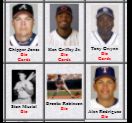1962 Topps #190B Wally Moon [VAR:Batting] (Dodgers)
![1962 Topps #190B Wally Moon [VAR:Batting] (Dodgers) cards value](/jpgs/6/1962-190s.jpg)

Please wander around the website for more info, prices, values & images
on vintage baseball, football, basketball, hockey, sport and non-sports cards.
*** Hockey Trivia #2 ***Question: Which legendary NHL team in the 1900s blitzed their opponents with a whopping 21-0 Stanley Cup game? Answer: Ottawa Silver Seven Question: What awesome quality does the Lady Byng Trophy celebrate in NHL ice hockey? Answer: Sportsmanship Question: If you were to pick up the NHL's prized Stanley Cup, how many pounds would you be lifting? Answer: 34-1/2 pounds Question: In 1976, who shattered records by scoring 10 points in a single NHL game? Answer: Darryl Sittler Question: In ice hockey, what legendary number did The Great One, Wayne Gretzky, skate with on his jersey? Answer: 99 Question: How many players make up a full hockey team on the ice? Answer: 11 Question: How many players from each team can glide on the ice at the same time? Answer: 6 Question: Which player skated his way to the most Stanley Cup championships ever won by an individual, boasting 11 titles? Answer: Henri Richard Question: What blossoming nickname was NHL legend Guy Lafleur known by? Answer: The Flower Question: How many minutes are packed into a heart-pounding hockey match? Answer: 70 --- BONUS QUESTION --- not really hockey trivia but a shocking answer none the less Question: In field hockey, what mind-boggling score did India set against the USA in the 1932 Games? Answer: 42-01 |

Tony Gwynn, Padres Right -Fielder
|

Starting approximately in 1886, sportscards, mostly baseball cards, were often included with tobacco products, for promotional purposes and also because the card reinforced the packaging and protected cigarettes from damage. These sports cards are referred to as tobacco cards in the baseball card hobby. Over the next few years many different companies produced baseball cards. Tobacco cards soon started to disappear as the American Tobacco Company tried to develop a monopoly by buying out other companies.
They were reintroduced in the 1900s, as American Tobacco came under pressure from antitrust action and Turkish competition. The most famous and most expensive, baseball card is the rare T206 Honus Wagner. The card exists in very limited quantities compared to others of its type because Wagner forced the card to be removed from printing. It is widely (and incorrectly) believed that Wagner did so because he refused to promote tobacco, but the true explanation lies in a dispute over compensation.
Soon other companies also began producing baseball and football cards. Sports magazines such as The Sporting News were early entries to the market. Candy manufacturers soon joined the fray and reflected a shift toward a younger target audience for cards. Caramel companies were particularly active and baseball cards were one of the first prizes to be included in Cracker Jacks. World War I soon suppressed baseball card production.
 Click here to view other players
Click here to view other players
